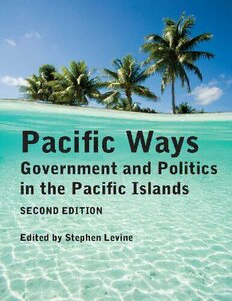
Pacific Ways: Government and Politics in the Pacific Islands PDF
Preview Pacific Ways: Government and Politics in the Pacific Islands
VICTORIA UNIVERSITY PRESS Victoria University of Wellington PO Box 600 Wellington vup.victoria.ac.nz Copyright © editor and contributors 2016 First published 2016 This book is copyright. Apart from any fair dealing for the purpose of private study, research, criticism or review, as permitted under the Copyright Act, no part may be reproduced by any process without the permission of the publishers National Library of New Zealand Cataloguing-in-Publication Data Pacific ways : government and politics in the Pacific Islands / edited by Stephen Levine. Second edition. ISBN 978-1-77656-068-4 (print) ISBN 978-1-77656-026-4 (EPUB) ISBN 978-1-77656-027-1 (Kindle) 1. Islands of the Pacific—Politics and government. I. Levine, Stephen I. 320.995—dc 23 Ebook conversion 2016 by meBooks Contents Front Cover Title Page Copyright Dedication Map of the Pacific Preface to the second edition Stephen Levine Introduction Stephen Levine Country Studies American Samoa J. Robert Shaffer & Cheryl Hunter Australia Nigel S. Roberts Cook Islands Phillipa Webb Federated States of Micronesia Glenn Petersen & Zag Puas Fiji Robert Norton French Polynesia Lorenz Gonschor Guam Kelly G. Marsh & Tyrone J. Taitano Kiribati Takuia Uakeia Marshall Islands David W. Kupferman Nauru Max Quanchi New Caledonia Nic Maclellan New Zealand Stephen Levine Niue Salote Talagi Northern Mariana Islands Frank Quimby Palau Wouter Veenendaal Papua New Guinea Vergil Narokobi Pitcairn Peter Clegg Rapa Nui / Easter Island Forrest Wade Young Samoa Iati Iati Solomon Islands Gordon Leua Nanau Timor-Leste / East Timor Michael Leach Tokelau Kelihiano Kalolo Tonga Steven Ratuva Tuvalu Jack Corbett & Jon Fraenkel Vanuatu Marc Lanteigne Wallis and Futuna Hapakuke Pierre Leleivai West Papua Gregory B. Poling Conclusion Political Institutions in the Pacific Islands Jon Fraenkel To my granddaughter Paige, child of the Pacific Preface to the second edition Stephen Levine Although the islands of the Pacific are popularly viewed as a tropical paradise, which fortunate outsiders (largely from Western countries, Japan and China) are briefly able to experience, a more prosaic reality regards Pacific Island countries and territories as entities with governments, rivalries, limited resources – in short, with politics, for better or for worse – situated on the same scale or continuum as all other nations and peoples, tranquil at some times, riven with divisions at others. In this sense the lovely photograph on the cover – a pristine scene of ocean, sandy beaches and palm trees, a glorious vision of a never-ending spring – is in stark contrast with the content and character of a book such as this. For Pacific Ways, first published in 2009, is about political reality – people and communities as they are, in this world of ours, where a beautiful backdrop is no guarantee against inequality, poverty and ethical shortcomings of one kind or another. Politicians in Pacific countries do not become heaven-sent simply by virtue of living in dramatically beautiful settings. And so this book, Pacific Ways, strives to discuss and document, in a clear and readable fashion, the political predicaments and institutional settings in which the residents of Pacific Island states and communities live together, organising themselves for the purposes of governance and nationhood. While this book, since published, has gone through reprintings, it was recognised that in due course a revised second edition would be necessary if it were to continue to achieve its broad purposes: to provide a reasonably up-to-date political narrative, and to convey information about governments, state institutions, political parties and political leadership that would be useful and accurate. A decision was taken, however, to defer putting together a second edition until Fiji had made its transition from military rule (instituted in 2006) to an elected government. In 2013, Fiji’s new constitution was approved and in 2014 elections were duly held; a new Parliament was inaugurated; and an elected government, with majority support in Parliament, was introduced. By these steps the Government of Fiji acquired greater legitimacy; the people of Fiji returned to elected government and constitutional rule; and – less dramatically – efforts to organise a new edition of Pacific Ways, its first edition’s chapter on Fiji now well and truly superceded by events, were set in motion. While much of the first edition of Pacific Ways retains its validity – background information about each country and territory, their political history and circumstances, and in most cases their institutional arrangements – seven years separate the two manuscripts. During that period each country and territory has experienced political changes of one kind or another: elections; leadership changes; new issues and emerging challenges. Accordingly, each chapter in the first edition of Pacific Ways – not merely the chapter about Fiji, but every other chapter as well – has been revisited, revised and rewritten, in some cases more substantially than others. In fact, the second edition of Pacific Ways is, in reality, an almost entirely new and different book: the same title, but a new work of research, scholarship and interpretation. The book has the same motivation and purpose, but the specific contents are separate and distinct. The first book retains its usefulness as a work to be drawn upon and consulted. It exists side by side with this second edition, a view of Pacific Islands government and politics from a group of authors writing during 2015. The distinctiveness of the second edition can be appreciated when it is noted that most of the contributors to this new book were not represented in the first edition. Of the chapters about the 16 full member states in the Pacific Islands Forum – Australia, the Cook Islands, the Federated States of Micronesia, Fiji, Kiribati, the Marshall Islands, Nauru, New Zealand, Niue, Palau, Papua New Guinea, Samoa, the Solomon Islands, Tonga, Tuvalu and Vanuatu – 12 have been written by new participants in this project. Of the three French-affiliated territories – French Polynesia, New Caledonia and Wallis and Futuna – one (Wallis and Futuna) has a new contributor. Each of
